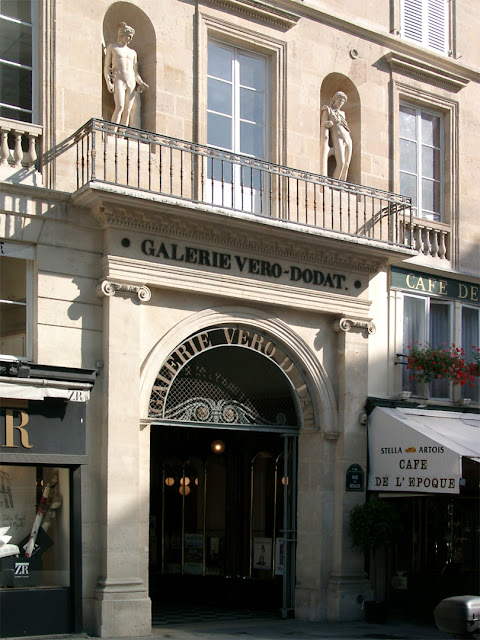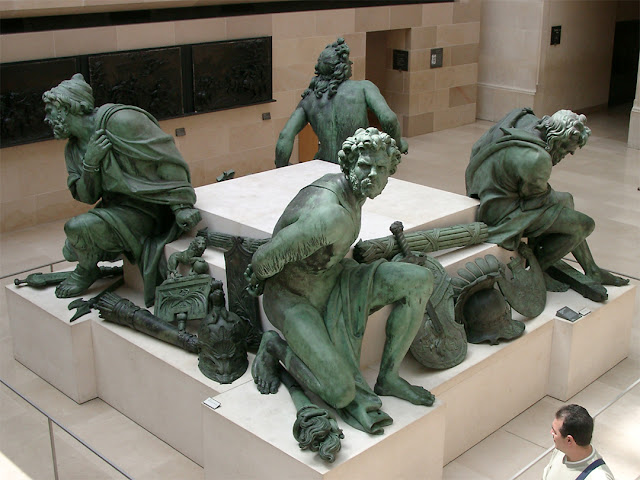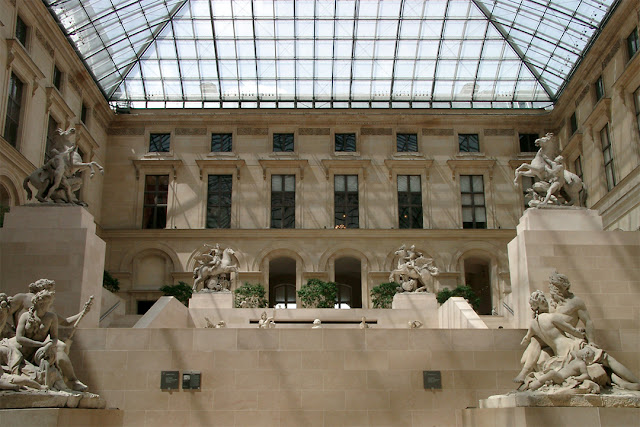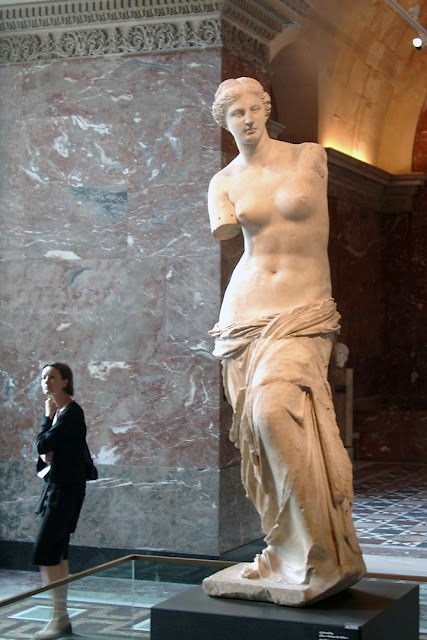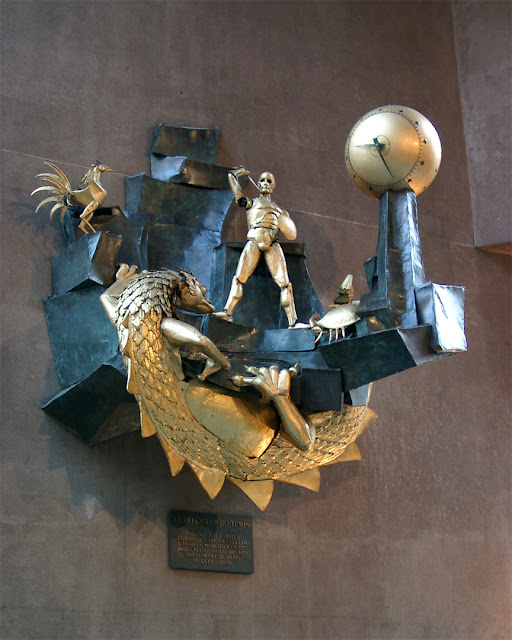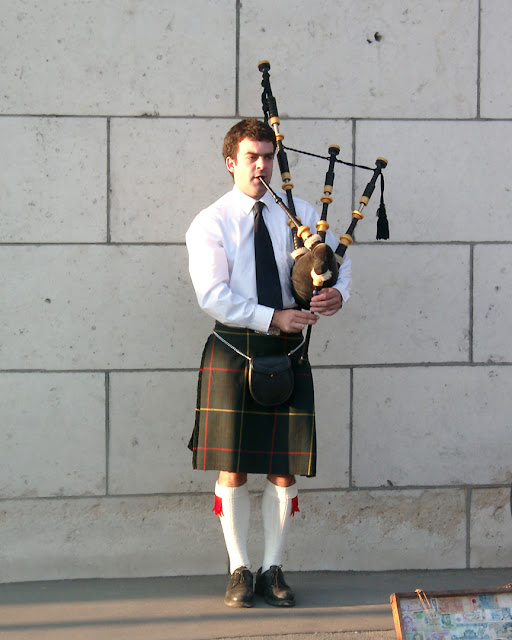Friday, October 31, 2003
Grande galerie
Grande galerie
Musée d'Orsay
Rue de la Légion d'Honneur
Quartier Saint-Thomas-d'Aquin, 7th arrondissement
Paris, July 2002
Thursday, October 30, 2003
The Gates of Hell
“La Porte de l'Enfer” (The Gates of Hell) by Auguste Rodin
Musée d'Orsay
Rue de la Légion d'Honneur
Quartier Saint-Thomas-d'Aquin, 7th arrondissement
Paris, July 2002
Wednesday, October 29, 2003
The Mature Age
L'Âge mûr (The Mature Age) by Camille Claudel, 1900
Musée d'Orsay
Rue de la Légion d'Honneur
Quartier Saint-Thomas-d'Aquin, 7th arrondissement
Paris, July 2002
Tuesday, October 28, 2003
Heroic bust of Victor Hugo
Victor Hugo, buste héroïque (heroic bust) by Auguste Rodin, 1902
Musée d'Orsay
Rue de la Légion d'Honneur
Quartier Saint-Thomas-d'Aquin, 7th arrondissement
Paris, July 2002
Monday, October 27, 2003
Claude Monet
Self Portrait by Claude Monet, 1917
Musée d'Orsay
Rue de la Légion d'Honneur
Quartier Saint-Thomas-d'Aquin, 7th arrondissement
Paris, July 2002
Sunday, October 26, 2003
Sully at sunset
Pavillon Sully at sunset
Musée du Louvre
Rue de Rivoli
Quartier Saint-Germain-l'Auxerrois, 1st arrondissement
Paris, July 2002
Saturday, October 25, 2003
Inside the pyramide
Pyramide du Louvre by I. M. Pei, 1989
Musée du Louvre
Rue de Rivoli
Quartier Saint-Germain-l'Auxerrois, 1st arrondissement
Paris, July 2002
Friday, October 24, 2003
Watching Hercules
Hercule combattant Achéloüs métamorphosé en serpent
(Hercules fighting Acheloos transformed into a snake)
By François Joseph Bosio, 1814 (Carbonneaux, 1824)
Musée du Louvre
Rue de Rivoli
Quartier Saint-Germain-l'Auxerrois, 1st arrondissement
Paris, July 2002
Thursday, October 23, 2003
Lamassu
Lamassu, Neo-Assyrian Empire, c. 721–705 BC Musée du Louvre
Rue de Rivoli
Quartier Saint-Germain-l'Auxerrois, 1st arrondissement
Paris, July 2002
“Lama, Lamma, or Lamassu is a Assyrian protective deity. Lamma, protective winged deity, Sumerian Isin-Larsa period (2000–1800 BC). Initially depicted as a goddess in Sumerian times, when it was called Lamma, it was later depicted from Assyrian times as a hybrid of a human, bird, and either a bull or lion—specifically having a human head, the body of a bull or a lion, and bird wings, under the name Lamassu. In some writings, it is portrayed to represent a goddess. A less frequently used name is shedu, which refers to the male counterpart of a lamassu.[6] Lamassu represent the zodiacs, parent-stars or constellations.” (Lamassu, Wikipedia)
Wednesday, October 22, 2003
Code of Hammurabi
Code of Hammurabi
Musée du Louvre
Rue de Rivoli
Quartier Saint-Germain-l'Auxerrois, 1st arrondissement
Paris, July 2002
“The Code of Hammurabi is a Babylonian writing on law from 1755–1750 BC. It is the best-preserved law collection from the ancient Near East, as well as the longest and best-organised. It is written in the Old Babylonian dialect of Akkadian, purportedly by Hammurabi, sixth king of the First Dynasty of Babylon. The primary copy of the text is on a basalt stele 2.25 metres tall. It was discovered in 1901, at the site of Susa in present-day Iran, where it had been taken as plunder six hundred years after its creation. However, the text was copied and studied by Mesopotamian scribes for over a millennium. The stele is now in the Louvre Museum.” (Code of Hammurabi, Wikipedia)
Tuesday, October 21, 2003
Galerie Véro-Dodat
Galerie Véro-Dodat
Rue Jean-Jacques-Rousseau - Rue du Bouloi
Quartier des Halles, 1st arrondissement
Paris, July 2002
Monday, October 20, 2003
Pizza Rico Grill
Pizza Rico Grill
Seen from the Galerie Véro-Dodat
Rue Jean-Jacques-Rousseau
Quartier des Halles, 1st arrondissement
Paris, July 2002
Sunday, October 19, 2003
Saturday, October 18, 2003
Galerie Vivienne
Galerie Vivienne by Francois Jean Delannoy, 1826
Rue des Petits Champs
Quartier Vivienne, 2nd arrondissement
Paris, July 2002
“The Galerie Vivienne is one of the covered passages of Paris, France, located in the 2nd arrondissement. It is 176 metres (577 ft) long and 3 metres (9.8 ft) wide. The gallery has been registered as a historical monument since 7 July 1974. The gallery was built in 1823 by Marchoux, President of the Chamber of Notaries, at the location of the Vanel de Serrant hotel and the Petits Peres passage. It was based on plans drawn up by the architect Francois Jean Delannoy. Inaugurated in 1826 under the name Marchoux, but soon renamed Vivienne, the gallery took advantage of its unique location. It attracted many visitors with its tailor shops, cobblers, wine shop, restaurant, Jousseaume bookstore, draper, confectioner, print-seller and so on. Located between the Palais-Royal, the Paris Bourse (stock exchange) and the Grands Boulevards, the passage enjoyed considerable success until the end of the Second Empire. But the gallery lost some of its appeal with the move of the prestigious shops to the Madeleine and the Champs-Élysées, and particularly because of the Restauration Haussmann of Paris by Georges-Eugène Haussmann.” (Galerie Vivienne, Wikipedia)
Friday, October 17, 2003
Rue des Petits-Champs
Galerie Vivienne by Francois Jean Delannoy, 1826
Rue des Petits-Champs
Quartier Vivienne, 2nd arrondissement
Paris, July 2002
“The Galerie Vivienne is one of the covered passages of Paris, France, located in the 2nd arrondissement. It is 176 metres (577 ft) long and 3 metres (9.8 ft) wide. The gallery has been registered as a historical monument since 7 July 1974. The gallery was built in 1823 by Marchoux, President of the Chamber of Notaries, at the location of the Vanel de Serrant hotel and the Petits Peres passage. It was based on plans drawn up by the architect Francois Jean Delannoy. Inaugurated in 1826 under the name Marchoux, but soon renamed Vivienne, the gallery took advantage of its unique location. It attracted many visitors with its tailor shops, cobblers, wine shop, restaurant, Jousseaume bookstore, draper, confectioner, print-seller and so on. Located between the Palais-Royal, the Paris Bourse (stock exchange) and the Grands Boulevards, the passage enjoyed considerable success until the end of the Second Empire. But the gallery lost some of its appeal with the move of the prestigious shops to the Madeleine and the Champs-Élysées, and particularly because of the Restauration Haussmann of Paris by Georges-Eugène Haussmann.” (Galerie Vivienne, Wikipedia)
Thursday, October 16, 2003
Louis XIV
Equestrian monument in honor of King Louis XIV by François Joseph Bosio, 1828
Place des Victoires
Quartier du Mail, 2nd arrondissement
Paris, July 2014
“In 1793, the Place was renamed Place des Victoires-Nationaux (National Victories Square), and a wooden pyramid was erected on the site of the destroyed statue. In 1810, under the rule of Napoléon I, a nude statue of the General Louis Desaix replaced the pyramid. However, following the abdication of Napoléon, the statue was taken down and its metal was used to create a new statue of Henry IV on the nearby Pont Neuf. In 1828, the restored Bourbon king, Charles X, commissioned the current equestrian statue, which was sculpted by François Joseph Bosio. Louis XIV, dressed as a Roman emperor, sits on a proud horse rearing on its hind legs. An iron fence encircles the twelve-meter-high statue.” (Place des Victoires, Wikipedia)
Wednesday, October 15, 2003
Pyramide du Louvre
Pyramide du Louvre by I. M. Pei, 1989
Musée du Louvre
Rue de Rivoli
Quartier Saint-Germain-l'Auxerrois, 1st arrondissement
Paris, July 2002
Tuesday, October 14, 2003
Quatre captifs
“Quatre captifs” (Four Captives) by Martin Desjardins, 1682
aka “Quatre nations vaincues” (Four Defeated Nations)
Cour Puget, Musée du Louvre
Rue de Rivoli
Quartier Saint-Germain-l'Auxerrois, 1st arrondissement
Paris, July 2002
“Taken from the pedestal of the statue in the Place des Victoires, these captives represent the nations defeated by the Treaty of Nijmegen (1679). Each expresses a different reaction to captivity: revolt, hope, resignation, or grief. They were first kept in the Invalides (1804-1939) then allocated to the Louvre in 1960 and placed in the grounds of the Château de Sceaux from 1961 to 1992.” (Four Captives, Musée du Louvre)
Monday, October 13, 2003
Sunday, October 12, 2003
Saturday, October 11, 2003
Mercure à cheval sur Pégase
“Mercure à cheval sur Pégase” by Antoine Coysevox, 1702
Cour Marly, Musée du Louvre
Rue de Rivoli
Quartier Saint-Germain-l'Auxerrois, 1st arrondissement
Paris, July 2002
Friday, October 10, 2003
La Renommée à cheval sur Pégase
“La Renommée à cheval sur Pégase” (Fame of Louis XIV) by Antoine Coysevox, 1702
Cour Marly, Musée du Louvre
Rue de Rivoli
Quartier Saint-Germain-l'Auxerrois, 1st arrondissement
Paris, July 2002
Thursday, October 9, 2003
Cour Marly
Cour Marly, Musée du Louvre
Rue de Rivoli
Quartier Saint-Germain-l'Auxerrois, 1st arrondissement
Paris, July 2002
Wednesday, October 8, 2003
Vénus de Milo
Vénus de Milo (Venus de Milo) by Alexandros of Antioch
Musée du Louvre
Rue de Rivoli
Quartier Saint-Germain-l'Auxerrois, 1st arrondissement
Paris, July 2002
“The Venus de Milo (Greek: Αφροδίτη της Μήλου, romanized: Afrodíti tis Mílou) is an ancient Greek sculpture that was created during the Hellenistic period, sometime between 150 and 125 BC. It is one of the most famous works of ancient Greek sculpture, having been prominently displayed at the Louvre Museum since shortly after the statue was rediscovered on the island of Milos, Greece, in 1820. The Venus de Milo is believed to depict Aphrodite, the Greek goddess of love, whose Roman counterpart was Venus. The sculpture is sometimes called the Aphrodite de Milos, due to the imprecision of naming the Greek sculpture after a Roman deity (Venus).[2] Some scholars theorize that the statue actually represents the sea-goddess Amphitrite, who was venerated on the island in which the statue was found. The work was originally attributed to the 4th century Athenian sculptor Praxiteles, but, based upon an inscription on its plinth, it is now widely agreed that the statue was created later, and instead is the work of Alexandros of Antioch. Made of Parian marble, the statue is larger than life size, standing 204 cm (6 ft 8 in) high. The statue is missing both arms, with part of one arm, as well as the original plinth, being lost after the statue's rediscovery.” (Venus de Milo, Wikipedia)
Tuesday, October 7, 2003
Victoire de Samothrace
Victoire de Samothrace (Winged Victory of Samothrace)
Musée du Louvre
Rue de Rivoli
Quartier Saint-Germain-l'Auxerrois, 1st arrondissement
Paris, July 2002
Monday, October 6, 2003
Napoleon Hall
Hall Napoléon (Napoleon Hall)
Musée du Louvre
Rue de Rivoli
Quartier Saint-Germain-l'Auxerrois, 1st arrondissement
Paris, July 2002
Sunday, October 5, 2003
Le Défenseur du Temps
“Le Défenseur du Temps” (The Defender of Time) by Jacques Monestier, 1979
Passage des Ménétriers
Rue Brantôme
Quartier de l'Horloge, 3rd arrondissement
Paris, July 2002
“Le Défenseur du Temps is a clock made of automata. Close to the dial, a man perched on a rock with a sword and shield fights against a bird, a dragon, and a crab which respectively represent air, earth, and water. As originally designed, every hour from 9 am to 10 pm, he fights one of the three animals chosen randomly by a program. At noon, 6 pm, and 10pm, all three animals attack at the same time. The time is announced by three strokes. While the man fights, he is accompanied by sounds of breaking waves, rumbling earth or the sound of wind, depending on the animal chosen. Le Défenseur du temps is 4 meters high and weighs about 1 ton. The characters, animals and the clock face are hammered brass and gold leaf. The rock on which they sit is composed of oxidized brass. In its original configuration, a master electronic quartz circuit board controlled the random attacks chance, and used six cam timers and five tape recorders.” (Le Défenseur du Temps, Wikipedia)
Saturday, October 4, 2003
Place Sainte-Opportune
Édicule Guimard (Recreated)
Place Sainte-Opportune
Quartier des Halles, 1st arrondissement
Paris, July 2002
“Ninety-one Guimard entrances survived until 1970. Eighty-six are still extant and protected as historical monuments; six were protected in 1965, the remainder in 1978. These include two original Type B édicules: at Porte Dauphine, on its original site and with the wall panels, and at Abbesses (moved from Hôtel de Ville in 1974). A third Type B of varying form at Châtelet is a 2000 recreation. The remainder of the preserved entrances are simple enclosures or entourages, with or without the light and sign arch. In addition, two sides of an entourage form an entryway to the headquarters building of the RATP.” (Paris Métro entrances by Hector Guimard, Wikipedia)
Friday, October 3, 2003
Thursday, October 2, 2003
Wednesday, October 1, 2003
Subscribe to:
Posts (Atom)













